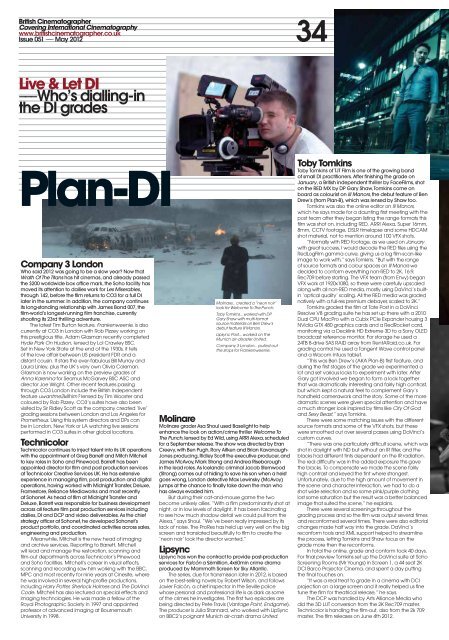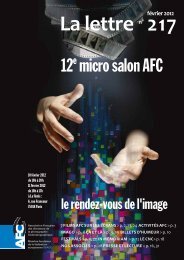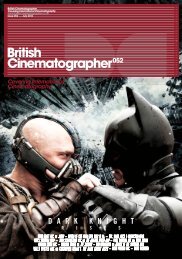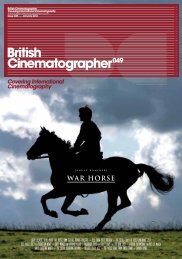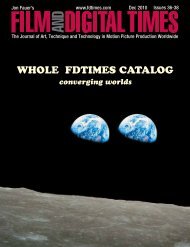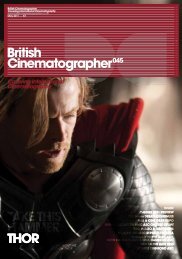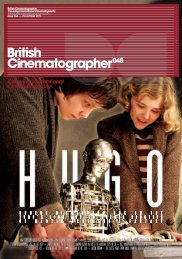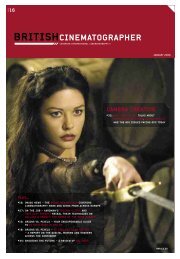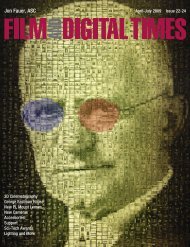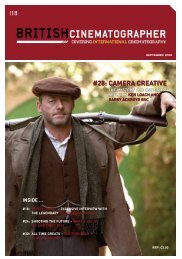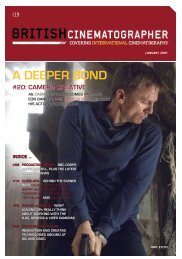British Cinematographer issue 51 - Imago
British Cinematographer issue 51 - Imago
British Cinematographer issue 51 - Imago
You also want an ePaper? Increase the reach of your titles
YUMPU automatically turns print PDFs into web optimized ePapers that Google loves.
<strong>British</strong> <strong>Cinematographer</strong><br />
Covering International Cinematography<br />
www.britishcinematographer.co.uk<br />
Issue 0<strong>51</strong> ––– May 2012 34<br />
Live & Let DI<br />
–––Who’s dialling-in<br />
the DI grades<br />
Plan-DI<br />
Company 3 London<br />
Who said 2012 was going to be a slow year? Now that<br />
Wrath Of The Titans has hit cinemas, and already passed<br />
the $200 worldwide box office mark, the Soho facility has<br />
moved its attention to dailies work for Les Miserables,<br />
through 142, before the film returns to CO3 for a full DI<br />
later in the summer. In addition, the company continues<br />
its long-standing relationship with James Bond 007, the<br />
film-world’s longest-running film franchise, currently<br />
shooting its 23rd thrilling adventure.<br />
The latest Tim Burton feature, Frankenweenie, is also<br />
currently at CO3 in London with Rob Pizzey working on<br />
this prestigious title. Adam Glasman recently completed<br />
Hyde Park On Hudson, lensed by Lol Crawley BSC.<br />
Set in New York State at the end of the 1930s, it tells<br />
of the love affair between US president FDR and a<br />
distant cousin. It stars the ever-fabulous Bill Murray and<br />
Laura Linley, plus the UK’s very own Olivia Coleman.<br />
Glasman is now working on the preview grades of<br />
Anna Karenina for Seamus McGarvey BSC ASC and<br />
director Joe Wright. Other recent features passing<br />
through CO3 London include the <strong>British</strong> Independent<br />
feature uwantme2killhim? lensed by Tim Wooster and<br />
coloured by Rob Pizzey. CO3’s suites have also been<br />
visited by Sir Ridley Scott as the company created ‘live’<br />
grading sessions between London and Los Angeles for<br />
Prometheus. Using this system directors and DPs can<br />
be in London, New York or LA watching live sessions<br />
performed in CO3 suites in other global locations.<br />
Technicolor<br />
Technicolor continues to inject talent into its UK operations<br />
with the appointment of Greg Barrett and Mitch Mitchell<br />
to key roles in Soho and Pinewood. Barrett has been<br />
appointed director for film and post production services<br />
at Technicolor Creative Services UK. He has extensive<br />
experience in managing film, post production and digital<br />
operations, having worked with Midnight Transfer, Deluxe,<br />
Framestore, Reliance Mediaworks and most recently<br />
at Sohonet. As head of film at Midnight Transfer and<br />
Deluxe, Barrett was responsible for business development<br />
across all feature film post production services including<br />
dailies, DI and DCP and video deliverables. As the chief<br />
strategy officer at Sohonet, he developed Sohonet’s<br />
product portfolio, and coordinated activities across sales,<br />
engineering and production.<br />
Meanwhile, Mitchell is the new head of imaging<br />
and archive services. Reporting to Barrett, Mitchell<br />
will lead and manage the restoration, scanning and<br />
film-out departments across Technicolor’s Pinewood<br />
and Soho facilities. Mitchell’s career in visual effects,<br />
scanning and recording saw him working with the BBC,<br />
MPC and most recently for nine years at Cinesite, where<br />
he was involved in several high-profile productions,<br />
including Harry Potter, Sherlock Holmes and The DaVinci<br />
Code. Mitchell has also lectured on special effects and<br />
imaging technologies. He was made a fellow of the<br />
Royal Photographic Society in 1997 and appointed<br />
professor of advanced imaging at Bournemouth<br />
University in 1998.<br />
Molinare... created a “neon noir”<br />
look for Welcome To The Punch.<br />
Toby Tomkins... worked with DP<br />
Gary Shaw with multi-format<br />
source materials on Ben Drew’s<br />
debut feature Ill Manors.<br />
Lipsync Post... worked on the<br />
Munich air-disaster United.<br />
Company 3 London... pulled out<br />
the stops for Frankenweenie.<br />
Molinare<br />
Molinare grader Asa Shoul used Baselight to help<br />
enhance the look on action/crime thriller Welcome To<br />
The Punch, lensed by Ed Wild, using ARRI Alexa, scheduled<br />
for a September release. The show was directed by Eran<br />
Creevy, with Ben Pugh, Rory Aitken and Brian Kavanaugh-<br />
Jones producing, Ridley Scott the executive producer, and<br />
James McAvoy, Mark Strong and Andrea Riseborough<br />
in the lead roles. As Icelandic criminal Jacob Sternwood<br />
(Strong) comes out of hiding to save his son when a heist<br />
goes wrong, London detective Max Lewinsky (McAvoy)<br />
jumps at the chance to finally take down the man who<br />
has always evaded him.<br />
But during their cat-and-mouse game the two<br />
become unlikely allies. “With a film predominantly shot at<br />
night, or in low levels of daylight, it has been fascinating<br />
to see how much shadow detail we could pull from the<br />
Alexa,” says Shoul. “We’ve been really impressed by its<br />
lack of noise. The ProRes has held up very well on the big<br />
screen and translated beautifully to film to create the<br />
‘neon noir’ look the director wanted.”<br />
Lipsync<br />
Lipsync has won the contract to provide post-production<br />
services for Falcón a £6million, 4x60min crime drama<br />
produced by Mammoth Screen for Sky Atlantic.<br />
The series, due for transmission later in 2012, is based<br />
on the best-selling novels by Robert Wilson, and follows<br />
Javier Falcón, a chief inspector in the Seville police<br />
whose personal and professional life is as dark as some<br />
of the crimes he investigates. The first two episodes are<br />
being directed by Pete Travis (Vantage Point, Endgame).<br />
The producer is Julia Stannard, who worked with LipSync<br />
on BBC2’s poignant Munich air-crash drama United.<br />
35<br />
Toby Tomkins<br />
Toby Tomkins of TJT Film is one of the growing band<br />
of small DI practitioners. After finishing the grade on<br />
January, a <strong>British</strong> independent thriller by FaceFilms, shot<br />
on the RED MX by DP Gary Shaw, Tomkins come on<br />
board as colourist on Ill Manors, the debut feature of Ben<br />
Drew’s (from Plan-B), which was lensed by Shaw too.<br />
Tomkins was also the online editor on Ill Manors,<br />
which he says made for a daunting first meeting with the<br />
post team after they began listing the range formats this<br />
film was shot on, including RED, ARRI Alexa, Super 16mm,<br />
8mm, CCTV footage, DSLR timelapse and some HDCAM<br />
shot material, not to mention around 100 VFX shots.<br />
“Normally with RED footage, as we used on January<br />
with great success, I would decode the RED files using the<br />
RedLogFilm gamma curve, giving us a log film-scan-like<br />
image to work with,” says Tomkins. “But with the range<br />
of source formats and colour spaces on Ill Manors we<br />
decided to conform everything non-RED to 2K, 16:9,<br />
Rec709 before starting. The VFX team (from Envy) began<br />
VFX work at 1920x1080, so these were carefully upscaled<br />
along with all non-RED media, mostly using DaVinci’s builtin<br />
‘optical quality’ scaling. All the RED media was graded<br />
natively with a full-res premium debayer, scaled to 2K.”<br />
Tomkins graded the film at Tate Post in a DaVinci<br />
Resolve V8 grading suite he has set up there with a 2010<br />
Dual CPU MacPro with a Cubix PCIe Expander housing 3<br />
NVidia GTX 480 graphics cards and a RedRocket card,<br />
monitoring via a Decklink HD Extreme 3D to a Sony OLED<br />
broadcast reference monitor. For storage he used a<br />
24TB 8-drive SAS RAID array from RentARaid.co.uk. For<br />
grading control he used a Tangent Wave control panel<br />
and a Wacom Intuos tablet.<br />
“This was Ben Drew’s (AKA Plan-B) first feature, and<br />
during the first stages of the grade we experimented a<br />
lot and set various looks to experiment with later. After<br />
Gary got involved we began to form a look together<br />
that was dramatically interesting and fairly high contrast,<br />
but which kept a natural feel to complement Gary’s<br />
handheld camerawork and the story. Some of the more<br />
dramatic scenes were given special attention and have<br />
a much stronger look inspired by films like City Of God<br />
and Sexy Beast,” says Tomkins.<br />
There were some matching <strong>issue</strong>s with the different<br />
source formats and some of the VFX shots, but these<br />
were smoothed out over several passes using DaVinci’s<br />
custom curves.<br />
“There was one particularly difficult scene, which was<br />
shot in daylight with ND but without an IR filter, and the<br />
blacks had different tints dependent on the IR radiation.<br />
The real difficulty was in the added exposure this gave<br />
the blacks. To compensate we made the scene fairly<br />
high contrast and keyed the tint where strongest.<br />
Unfortunately, due to the high amount of movement in<br />
the scene and character interaction, we had to do a<br />
shot wide selection and so some pink/purple clothing<br />
lost some saturation but the result was a better balanced<br />
image that suited the scene,” he explains.<br />
There were several screenings throughout the<br />
grading process and so the film was output several times<br />
and reconformed several times. There were also editorial<br />
changes made half way into the grade. DaVinci’s<br />
reconform tools and XML support helped to streamline<br />
the process, letting Tomkins and Shaw focus on the<br />
grade more then the reconforms.<br />
In total the online, grade and conform took 40 days.<br />
For final preview Tomkins set up the DaVinci suite at Soho<br />
Screening Rooms (Mr Youngs) in Screen 1, a 44 seat 2K<br />
DCI Barco Projector Cinema, and spent a day putting<br />
the final touches on.<br />
“It was a real treat to grade in a cinema with DCI<br />
projection on a large screen and it really helped us fine<br />
tune the film for theatrical release,” he says.<br />
The DCP was handled by Arts Alliance Media who<br />
did the 3D LUT conversion from the 2K Rec709 master.<br />
Technicolor is handling the film-out, also from the 2k 709<br />
master. The film releases on June 4th 2012.<br />
<strong>British</strong> <strong>Cinematographer</strong><br />
Covering International Cinematography<br />
www.britishcinematographer.co.uk<br />
Issue 0<strong>51</strong> ––– May 2012<br />
FotoKem<br />
FotoKem has appointed Joseph Slomka as its VP and<br />
principal colour scientist for digital post-production and<br />
creative picture services.<br />
Slomka will spearhead the execution of color<br />
science, management and best practices for FotoKem’s<br />
extensive picture production chain, from location<br />
services to distribution masters. Before joining the<br />
FotoKem team, Slomka served for six years as colour<br />
scientist at Sony Pictures Imageworks, managing<br />
the colour pipeline for over 30 major studio pictures<br />
in addition to multiple facility projects. His extensive<br />
industry experience also includes working closely with<br />
the Science and Technology Council of the Academy<br />
of Motion Picture Arts and Sciences in the development<br />
of the Image Interchange Framework (IIF) and the<br />
Academy Color Encoding Specifications (ACES).<br />
Company 3 LA<br />
Stefan Sonnenfeld graded Universal Pictures’ Battleship,<br />
lensed by Tobias Schliessler with Peter Berg directing,<br />
and Paramount Pictures’ G.I. Joe: Retaliation, lensed by<br />
Stephen Windon ACS with Jon M. Chu at the helm. For<br />
Prometheus, director Ridley Scott has returned to the<br />
world of outer-space horror that was the setting of his first<br />
breakout feature Alien.<br />
The film, starring Charlize Theron and Michael<br />
Fassbender, and shot in 3D by Dariusz Wolski ASC, is set in<br />
the shadowy darkness of deep space where something<br />
scary could jump out at any moment. Company 3<br />
LA Colorist Stephen Nakamura made use of DaVinci<br />
Resolve’s aperture correction feature to add a little bit<br />
of sharpening to small, isolated portions of the frame, a<br />
technique he also used with Scott for Robin Hood.<br />
“I could apply the effect to a face or an object<br />
in the frame,” the colorist says, “and as soon as the<br />
film cuts to that shot, your eye is drawn to that exact<br />
spot. It’s almost like subliminally limiting the depth-offield<br />
in the shot and it can be very effective. But whilst<br />
the effect looks perfect through 3D glasses, it doesn’t<br />
work the same for the 2D version. Those glasses soften<br />
everything including the effect. For the 2D version, I<br />
have to decrease the effect for every shot we used it<br />
in, because without the glasses that level of sharpening<br />
looks excessive and artificial.”<br />
EFILM LA<br />
EFILM LA’s Steve Scott worked with DP Bill Pope and<br />
director Barry Sonnenfeld to grade Columbia Pictures’<br />
Men In Black III, and with DP Seamus McGarvey BSC<br />
ASC on Walt Disney Studios Motion Pictures’ The Avengers<br />
directed by Joss Whedon. Colourist Yvan Lucas graded<br />
Universal Pictures’ Snow White And The Huntsman, lensed<br />
by Greig Fraser ACS and directed by Rupert Sanders,<br />
plus the DreamWorks picture People Like Us, shot by<br />
Salvatore Totino and directed by Alex Kurtzman.<br />
Meanwhile Natasha Leonnet, dialled in the DI grade<br />
on the Kirk Jones-helmed What To Expect When You’re<br />
Expecting for Lionsgate, shot by Xavier Pérez Grobet.<br />
Soundfirm<br />
Soundfirm, the renowned Australian feature soundmixing<br />
and editing facility has invested in a Mistika 2K<br />
finishing system with advanced DI colour grading and<br />
stereo 3D options. Soundfirm is located at Fox Studios in<br />
Sydney, and has premises in Melbourne and Beijing.<br />
Digitaline<br />
Digitaline, a cutting-edge visual effects post house,<br />
based in the centre of Paris, has stepped up its colour<br />
grading capabilities, by purchasing a Mistika HD and DI<br />
post production system.<br />
Film Factory<br />
The Paris-based post house, helped to finish Relativity<br />
Media’s recently released Mirror Mirror, Tarsem Singh’s<br />
stylized retelling of the Snow White tale, lensed by<br />
Brendan Galvin. Lionel Kopp, founder of Film Factory and<br />
one of the world’s leading colourists, used Digital Vision’s<br />
Nucoda Film Master, which marries a powerful on-set<br />
solution to the final colour pass. The Film Master system,<br />
which included a SAN and Nucoda Fuse assist station,<br />
was installed on set in Montreal. From the set, Kopp<br />
did a grading pass of the Sony F35 dailies, which were<br />
then sent to the editing room with the colour settings. In<br />
some cases, a further grading took place prior to dailies<br />
screening in the DI suite with the director and crew.<br />
Designing this system meant that the dailies – from the<br />
set through screening and ultimately delivery – were kept<br />
in a closely matched, carefully monitored environment.<br />
Kopp graded every take from the first day of dailies<br />
through to the completion of the DI. Colourist Marc<br />
Boucrot also worked on the project for Film Factory.<br />
There were nearly 1,300 visual effects shots in the<br />
movie, and Kopp states, “The Nucoda enabled us to<br />
have one central hub, where dailies colour settings,<br />
visual effects and eventually the DI was managed. There<br />
were VFX vendors from all over the world, but the VFX<br />
Supervisor, Tom Wood, was in house with us in Montreal<br />
during the shoot, and in the post production building<br />
at Wildfire Studios in Los Angeles where editing, sound<br />
editing and mixing, and DI rooms were all together. As<br />
VFX shots came in, we were able to look at them in the<br />
DI rooms and see how they were working. The ability to<br />
have all of these activities going on in one location, our<br />
facility, was crucial given the timeframe and the visual<br />
style of the movie. Helping Tarsem execute his vision<br />
for Mirror Mirror was our first priority. Every project we<br />
undertake is an artistic and technical process, and we<br />
plan and execute how to do that in the best way, from<br />
day one to the final delivery.”


